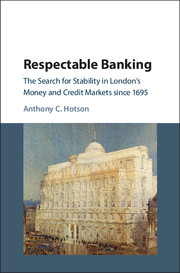Book contents
- Respectable Banking
- Respectable Banking
- Copyright page
- Contents
- Tables
- Figures
- Acknowledgements
- Abbreviations
- Select List of Institutions by Functional Type
- 1 Introduction
- 2 Principles and Practice
- 3 Minted Currency and the Bullion Market
- 4 Credit Markets and Clearing Banks
- 5 Liability Management Redux
- 6 Bankers against Speculation
- 7 History and Policy
- Appendix – English Mint Prices, 1158–1946 (Tables A.1 to A.7)
- Glossary of Technical Terms
- Bibliography
- Index
- References
Bibliography
Published online by Cambridge University Press: 04 July 2017
- Respectable Banking
- Respectable Banking
- Copyright page
- Contents
- Tables
- Figures
- Acknowledgements
- Abbreviations
- Select List of Institutions by Functional Type
- 1 Introduction
- 2 Principles and Practice
- 3 Minted Currency and the Bullion Market
- 4 Credit Markets and Clearing Banks
- 5 Liability Management Redux
- 6 Bankers against Speculation
- 7 History and Policy
- Appendix – English Mint Prices, 1158–1946 (Tables A.1 to A.7)
- Glossary of Technical Terms
- Bibliography
- Index
- References
- Type
- Chapter
- Information
- Respectable BankingThe Search for Stability in London's Money and Credit Markets since 1695, pp. 235 - 272Publisher: Cambridge University PressPrint publication year: 2017



